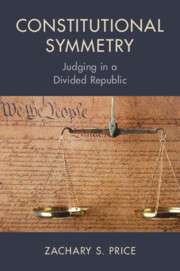Symmetry in Interpreting the First Amendment and the Structural Constitution

My earlier posts on my book Constitutional Symmetry explained the basic idea of favoring symmetry and summarized the practical and theoretical reasons for this approach. In addition to advancing this theoretical case for symmetry, the book includes chapters applying the theory to five contested areas of constitutional law: speech, association, and religion; separation of powers and federalism; equal protection; guns and fundamental rights; and the law of democracy.
The chapters themselves are more illustrative than exhaustive. As I explain, they do not address every relevant case or holding in the areas they cover, and they omit entirely major areas of constitutional law. The chapters do aim, however, to demonstrate that comparatively symmetric approaches remain open in many areas as potential pathways of case law development, if the courts will only take them.
In these posts, I can only briefly sketch the book’s argument, so I encourage readers to consult the relevant chapters for more detail. I designed the book so that the chapters are self-contained. You could read the introduction and the chapters on particular substantive areas without necessarily reading the rest.
With respect to the First Amendment, the book makes two main points. The first is that symmetry should support maintaining current doctrine’s focus on requiring neutrality in laws regulating free expression.
Modern First Amendment doctrine requires content-neutrality (or sometimes viewpoint-neutrality) in expressive regulation. As I noted in my first post, this case law offers a paradigm case of symmetry. By preventing the government from taking sides, it equally protects speakers of all sorts, no matter where they fall on the ideological spectrum. For that reason, moreover, it gives all sides of our divided polity a stake in maintaining the crucial civil liberty of free expression. Those disappointed by the immediate result in one case should recognize that the principle being applied may equally benefit them (or speakers they care about) in future cases.
The justices seem to recognize the virtues of this orientation towards neutrality. Indeed, this area of doctrine has remained a striking point of consensus on the current Court, even as tolerance for competing points of view seems to have waned in the broader society. The justices seem to recognize that both sides of our divided polity may feel tempted to repress dissent within the spaces and institutions they control, and that courts can help interrupt the downward spiral of speech repression that such partisan dynamics could easily generate. Symmetry should encourage judges to maintain this focus notwithstanding recent scholarship questioning this orientation towards neutrality on various grounds.
The book’s second main point regarding the First Amendment is that symmetry should also support protecting religious speakers and groups, when possible, through decisions rooted in expressive freedom and freedom of association rather than religious liberty per se.
The First Amendment, of course, singles out religion for special protection in the Free Exercise and Establishment Clauses, and revitalizing religious liberty has been a major project of the Roberts Court. But these decisions have often proved divisive and polarizing in the current climate.
Religious liberty today has this polarizing character because religion now is largely associated with conservatism. The association, to be sure, is not total. Some important denominations have a strong progressive bent and some religious groups, most notably African American churchgoers, identify strongly with the Democratic Party. On the whole, however, regular church attendance in the contemporary United States correlates with Republican Party affiliation, and affiliation with the Democratic party appears to be particularly strong within a growing group of Americans who “affirmatively embrace a distinctively secular worldview,” as one recent study puts it.
These demographic patterns are comparatively recent; they did not exist even a couple decades ago. Yet they have made religion a major fault line in American politics, not to mention a major point of division between judges appointed by Democratic and Republican presidents. Religion-specific rulings are asymmetric in the current context because they extend protections to religious believers that, by definition, cannot equally protect those with a self-consciously secular outlook.
To avoid exacerbating these divisions, courts should rely instead, whenever possible, on broader protections for free expression and freedom of association. Doing so would blunt the critique that the Court is favoring groups on one side of contemporary divides over those on the other. Ironically, that approach might even place religious liberty on stronger footing in the long run. If, for example, the First Amendment equally protects religious and secular entrepreneurs from compelled expression of viewpoints they abhor—a point the Court took pains to emphasize in its recent, commendably symmetric decision in 303 Creative LLC v. Elenis—then perhaps each side will feel less need to impose its viewpoint on the other.
As concerns the structural constitution, symmetry should often be comparatively easy to apply. A defining feature of recent political polarization has been the absence of any consistent pattern of partisan control over federal institutions. Whereas in earlier eras one party or the other often dominated the presidency or Congress (or one or the other house), partisan control of the House, Senate, and presidency has flipped back and forth with no regular pattern in recent decades.
As a result, it should be easy to anticipate a given authority or constraint applying in politically opposite circumstances in the future and assess its validity accordingly. In practice, however, partisanship has often led partisans to seek immediate advantage instead even when doing so advances legal theories that could work to their detriment in the future. If nothing else, symmetric interpretation should encourage courts and other interpreters to self-consciously resist this impulse and take the long view instead.
Beyond this general recommendation, a preference for symmetry could help mollify concerns about some doctrines while sharpening the critique of some others. The book argues, for example, that the long-running debate over the President’s power to fire or “remove” executive officers lacks clear partisan stakes at present. By contrast, recent developments in administrative law have been sharply asymmetric.
In its recent “major questions doctrine” decisions, for instance, the Court has given effect to conservative anxieties about administrative governance by requiring clear statutory support for any agency action that addresses a question of major societal importance. Given, however, that progressives generally hold a more assertive regulatory agenda, these decisions seem likely to limit progressive administrations more than conservative ones. Furthermore, even if some conservative or deregulatory policies could conceivably fall afoul of the doctrine, the Court’s criteria for identifying “major questions” are subjective and amorphous. As a result, the Court’s current conservative majority could easily end up applying the doctrine selectively in a manner that favors conservative policy goals in practice. That is not how a symmetric body of administrative law should operate.
Symmetry thus affords a powerful reason to favor some pathways over others in future cases regarding both the First Amendment and separation of powers. In my last post, I will argue that the same is true in the still more fraught areas of equal protection, fundamental rights, and the law of democracy.
The post Symmetry in Interpreting the First Amendment and the Structural Constitution appeared first on Reason.com.
